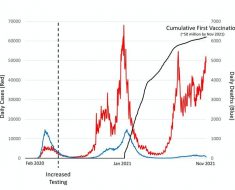
Making a connection between the flu and the risk of subsequent heart problems significantly increased flu vaccination rates among older Danish adults, according to a study presented at the American College of Cardiology’s Annual Scientific Session Together With the World Congress of Cardiology. A reminder message the day before the start of a national vaccine program also helped “nudge” people to get vaccinated.
Each year, seasonal influenza accounts for more than 500,000 deaths globally and certain high-risk groups are disproportionately affected, including older adults and those with diabetes, heart disease and other chronic conditions. An annual flu shot is widely recommended to prevent influenza infection or lessen its severity and complications should someone get sick. Still, vaccination rates aren’t nearly what they should be in many countries, including the U.S., and that’s especially true for younger people with chronic diseases like heart disease.
“Figuring out ways to increase the percentage of people who get the flu [shot] and other vaccines is important,” said Tor Biering-Sørensen, MD, MSc, MPH, Ph.D., professor, Center for Translational Cardiology and Pragmatic Randomized Trials, Copenhagen University Hospital, Hellerup, Denmark, and the study’s chief investigator. “Vaccines help prevent infectious diseases and for flu, specifically, many countries lag well behind the WHO recommendation for over 75% of the population to be vaccinated.”
While earlier studies have tested different nudge strategies—that is, messages designed specifically to educate, remind and push positive health behaviors—to increase flu vaccination in select populations, this study is the largest of its kind and involved all adults 65 years or older in Denmark.
The NUDGE-FLU trial randomized 964,870 Danish citizens across 691,820 households to receive one of nine different electronic letters featuring a specific message about the upcoming flu season and the need for vaccination to see which, if any, would increase influenza vaccination uptake among older adults. The communications were delivered via the country’s electronic letter system on September 16, 2022. Citizens were either in usual care (no letter) or they received one of nine nudge strategies (participants were randomized 1:1, so for every citizen receiving no letter, one received one of the nine intervention letters). In addition to the letter that linked the flu vaccine with a reduction of cardiovascular events, and the approach that sent the standard flu pamphlet two weeks before the flu season started and a reminder on the day the vaccine became widely available, the other seven messages included:
- A clear recommendation from a leading health authority to get vaccinated
- A nudge for people not to be in the minority and to get vaccinated
- A nudge to join the majority to prevent the flu from spreading (collective goal)
- The role flu vaccination can play in helping in a pandemic to protect you and your loved ones (gain framing)
- The danger of too few people getting vaccinated placing you and your loved ones at risk (loss framing)
- A prompt to make a plan to get vaccinated and record their appointment in a space provided; and
- A basic letter without name personalization
The primary endpoint was the receipt of influenza vaccination on or before January 1, 2023; while flu vaccination can continue throughout the influenza season, fall is the ideal time to assure protection.
Compared with usual care, influenza vaccination rates were significantly higher in the group receiving a letter highlighting potential cardiovascular benefits of vaccination (81% vs. 80.12%) and the group receiving repeat letters about the importance of flu vaccination generally and to let them know about available flu vaccines at the start of the study and 14 days later (80.85% vs. 80.12%).
“The only two nudge strategies that significantly increased flu vaccine uptake were the simple reminder and explaining that flu vaccination may also prevent cardiovascular events,” Biering-Sørensen said.
He added that these strategies improved vaccination rates across major subgroups, including participants with cardiovascular disease. The cardiovascular benefits message, which stated that “in addition to its protection against influenza infection, influenza vaccination also seems to protect against cardiovascular disease, such as heart attacks and heart failure,” resulted in a greater increase in vaccine uptake among the participants who had not been vaccinated for influenza in the prior season.
Biering-Sørensen said he expects these increases in flu vaccine uptake may have been even more pronounced in countries where vaccination rates are low. Denmark has among the highest flu vaccine rates to start with—more than 80% this season. During the 2021-2022 influenza season, only 49% of U.S. adults received a flu vaccine, despite widespread recommendations for annual flu vaccination.
More research is needed to test the messaging around the flu and related cardiovascular outcomes given that was the most effective message to boost flu vaccination.
“As cardiologists, it’s very interesting that just telling people that we can also prevent other downstream issues like cardiovascular outcomes was what worked the best of all the nudge strategies—even better than the reminder, which we expected would be positive,” Biering-Sørensen said. “A lot of studies have shown that people who get the flu vaccine have a lower risk of cardiovascular outcomes, and there may be protective effects [for the heart] that are not specific to flu infection. The flu vaccine may have broader benefits that we don’t yet know.”
He said that these improvements were accomplished through a simple email, making it a replicable and very low-cost intervention that could help prevent flu-related deaths and associated complications. They will be further analyzing the data to see if certain nudge messages worked better in people with diabetes and other chronic conditions.
The study is limited to the Danish population, which has free access to influenza vaccination, so the bump in vaccine uptake may be different if cost is a barrier.
This study was simultaneously published online in The Lancet at the time of presentation; a pre-specified analysis of the trial was simultaneously published online in the journal Circulation.
More information:
Niklas Dyrby Johansen presented the study, “A Nationwide Randomized Trial Of Electronically Delivered Nudges To Increase Influenza Vaccination Uptake: The NUDGE-FLU Trial,” on Sunday, March 5, in the Great Hall.
The study was funded by Sanofi.
Journal information:
Circulation
,
The Lancet
Source: Read Full Article





